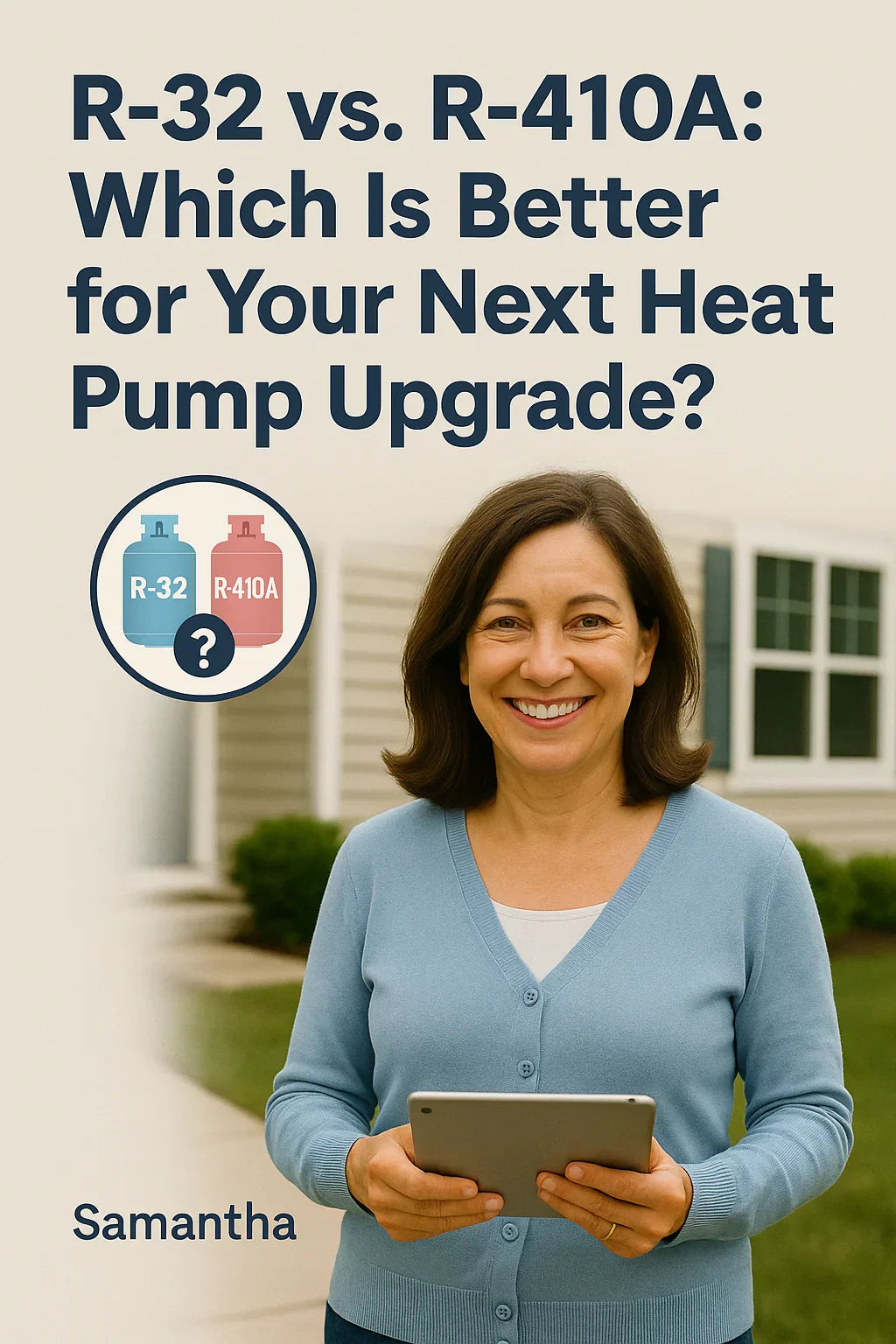🔍 Introduction: Why Refrigerant Choice Matters
If you’re anything like me, you might have assumed that upgrading a heat pump is mostly about picking the right size and efficiency rating. But here’s the thing—your refrigerant choice can be just as important.
When I replaced my old heat pump in 2023, I was faced with two options: stick with R-410A, the tried-and-true refrigerant most systems have used for the past 20 years, or go with R-32, the newer, more eco-friendly kid on the block.
It wasn’t just a question of being “green”—it was about future-proofing my investment, ensuring peak efficiency, and making sure I wouldn’t be stuck with a hard-to-service system five years down the road.
📖 Quick Refresher: What Are R-32 and R-410A?
R-410A: The Old Standard
-
Introduced in the mid-1990s to replace R-22 (which was phased out for ozone depletion concerns).
-
Made up of two refrigerants: R-32 and R-125 in a 50/50 blend.
-
Pros: Safe (non-flammable), widely available, proven performance.
-
Cons: High Global Warming Potential (GWP), less energy efficient than R-32.
R-32: The Rising Star
-
A single-component refrigerant—actually one of the main ingredients in R-410A.
-
Pros: Lower GWP (~675), higher efficiency, easier to recycle, less refrigerant needed per system (Daikin).
-
Cons: Mildly flammable (A2L classification), meaning different handling and building code requirements.
Both refrigerants are HFCs (hydrofluorocarbons) and don’t harm the ozone layer, but their greenhouse gas impact varies significantly.
🌍 Environmental Impact: GWP & Regulations
This is where the two refrigerants really diverge.
| Refrigerant | GWP (100-year) | Ozone Depletion Potential (ODP) |
|---|---|---|
| R-410A | ~2,088 | 0 |
| R-32 | ~675 | 0 |
Why It Matters
-
Global Warming Potential (GWP) measures how much heat a gas traps compared to CO₂ (which has a GWP of 1).
-
Lower numbers = better for the climate.
Regulatory Changes
Under the AIM Act in the U.S., high-GWP refrigerants like R-410A are being phased down. This doesn’t mean R-410A is banned tomorrow, but it will get more expensive and harder to find over time.
R-32 already meets many of the upcoming regulatory targets, making it a future-ready choice.
⚡ Efficiency & Performance Differences
If you’re upgrading for lower energy bills, this section matters.
R-32 Efficiency Advantages
-
Heat transfer efficiency: R-32 absorbs and releases heat more effectively than R-410A.
-
Smaller charge volume: Systems require about 20% less refrigerant to achieve the same output (Carrier Engineering Data).
-
Higher SEER2 potential: Manufacturers can design more compact, energy-efficient coils.
R-410A Performance
-
Still very efficient compared to older refrigerants like R-22.
-
In colder climates, performance depends more on system design than refrigerant type—but R-32 often edges out in lab tests.
Example:
Tests by Goodman show R-32 systems delivering up to 10% better efficiency than comparable R-410A models.
🛠️ Installation & Maintenance Considerations
Compatibility
-
R-32 requires systems specifically designed for it—you can’t just “swap refrigerants” in an old R-410A system.
-
This is due to pressure, oil type, and flammability standards.
Servicing
-
R-410A: Widely supported by existing technician certifications.
-
R-32: Requires A2L training for safe handling and leak prevention (AHRI Safety Standards).
Safety Notes
R-32’s mild flammability sounds scary, but it’s considered very low risk when installed and maintained correctly. Think of it like handling natural gas or propane—code compliance and trained technicians make it safe.
💰 Cost Comparison: Short & Long Term
Upfront Costs
-
R-410A units may currently be slightly cheaper due to existing production scale.
-
R-32 units may carry a small premium, especially in markets just transitioning.
Long-Term Costs
-
R-32 systems tend to have lower energy bills thanks to better efficiency.
-
R-410A refrigerant prices will likely rise as production quotas drop
Example:
If refrigerant servicing is needed in 2028, R-32 could be half the price of R-410A due to supply trends.
📈 Future Availability & Phase-Out Timeline
-
R-410A: Gradual phase-down in the U.S. through 2036; no new high-GWP equipment after certain dates (likely mid-2020s for residential).
-
R-32: Already adopted widely in Asia, Europe, and Australia. U.S. adoption ramping quickly—major brands like Daikin, Carrier, and Goodman have released full R-32 product lines.
For homeowners, this means R-32 is a safer bet for long-term servicing and resale value.
✅ Decision Checklist: Which Should You Choose?
R-32 Might Be Best If:
-
You want future-proofing against regulations.
-
You prioritize energy efficiency and environmental impact.
-
You plan to stay in your home for at least 10 years.
R-410A Might Still Make Sense If:
-
You’re on a tight upfront budget.
-
Your preferred system model isn’t available in R-32 yet.
-
You’re replacing in a property you may sell soon.
💬 Samantha’s Final Take
For my own upgrade, I chose R-32—and here’s why:
-
It runs quieter and more efficiently.
-
I won’t be scrambling for refrigerant in a few years.
-
It feels good knowing I’ve reduced my home’s environmental footprint without sacrificing comfort.
If you’re upgrading soon, talk to your HVAC pro about R-32 options—and make sure they’re certified for A2L handling.
References & External Links Used
In the next topic we will read about: How Much Does a 3-Ton R-32 Heat Pump Cost in 2025? Budgeting Tips for Homeowners







